DEM-FDM Coupled Numerical Study on the Reinforcement of Biaxial and Triaxial Geogrid Using Pullout Test
Abstract
:1. Introduction
2. Experimental Pullout Test
3. DEM-FDM Coupled Modeling of Pullout Test
3.1. FDM Biaxial and Triaxial Geogrids Using FLAC3D
3.2. Calibration of FDM Geogrid Model
3.3. DEM-FDM Coupled Model of Pullout Test
4. Results and Discussion
4.1. Interaction Behavior between Particles and the Geogrid
4.2. Geogrid Deformation Behavior of Biaxial and Triaxial Geogrids
4.3. Particle Movement
4.4. Response of the Ballast Box and Surcharge Block
5. Conclusions
Author Contributions
Funding
Institutional Review Board Statement
Informed Consent Statement
Data Availability Statement
Acknowledgments
Conflicts of Interest
References
- Ma, K.; Wang, L.; Long, L.; Peng, Y.; He, G. Discrete Element Analysis of Structural Characteristics of Stepped Reinforced Soil Retaining Wall. Geomat. Nat. Hazards Risk 2020, 11, 1447–1465. [Google Scholar] [CrossRef]
- Kiersnowska, A.; Koda, E.; Fabianowski, W.; Kawalec, J. Effect of the Impact of Chemical and Environmental Factors on the Durability of the High Density Polyethylene (HDPE) Geogrid in a Sanitary Landfill. Appl. Sci. 2017, 7, 22. [Google Scholar] [CrossRef] [Green Version]
- Kim, Y.-J.; Kotwal, A.R.; Cho, B.-Y.; Wilde, J.; You, B.H. Geosynthetic Reinforced Steep Slopes: Current Technology in the United States. Appl. Sci. 2019, 9, 2008. [Google Scholar] [CrossRef] [Green Version]
- Koda, E.; Kiersnowska, A.; Kawalec, J.; Osiński, P. Landfill Slope Stability Improvement Incorporating Reinforcements in Reclamation Process Applying Observational Method. Appl. Sci. 2020, 10, 1572. [Google Scholar] [CrossRef] [Green Version]
- Kawalec, J.; Grygierek, M.; Koda, E.; Osiński, P. Lessons Learned on Geosynthetics Applications in Road Structures in Silesia Mining Region in Poland. Appl. Sci. 2019, 9, 1122. [Google Scholar] [CrossRef] [Green Version]
- Park, K.; Kim, D.; Park, J.; Na, H. The Determination of Pullout Parameters for Sand with a Geogrid. Appl. Sci. 2021, 11, 355. [Google Scholar] [CrossRef]
- Mosallanezhad, M.; Taghavi, S.H.S.; Hataf, N.; Alfaro, M.C. Experimental and Numerical Studies of the Performance of the New Reinforcement System under Pull-out Conditions. Geotext. Geomembr. 2016, 44, 70–80. [Google Scholar] [CrossRef]
- Abdi, M.R.; Mirzaeifar, H. Experimental and PIV Evaluation of Grain Size and Distribution on Soil–Geogrid Interactions in Pullout Test. Soils Found. 2017, 57, 1045–1058. [Google Scholar] [CrossRef]
- Yogarajah, I.; Yeo, K.C. Finite Element Modelling of Pull-out Tests with Load and Strain Measurements. Geotext. Geomembr. 1994, 13, 43–54. [Google Scholar] [CrossRef]
- Perkins, S.W.; Edens, M.Q. Finite Element Modeling of a Geosynthetic Pullout Test. Geotech. Geol. Eng. 2003, 21, 357–375. [Google Scholar] [CrossRef]
- Hussein, M.G.; Meguid, M.A. A Three-Dimensional Finite Element Approach for Modeling Biaxial Geogrid with Application to Geogrid-Reinforced Soils. Geotext. Geomembr. 2016, 44, 295–307. [Google Scholar] [CrossRef]
- Zhang, G.; Yang, Y.; Su, F. Parameter Optimization of Geogrid-Reinforced Foundations Based on Model Experiments and Numerical Simulations. Appl. Sci. 2019, 9, 3592. [Google Scholar] [CrossRef] [Green Version]
- Guadagnin Moravia, M.; Villard, P.; De Mattos Vidal, D. Geogrid Pull-out Modelling Using DEM. E3S Web Conf. 2019, 92, 13015. [Google Scholar] [CrossRef]
- Ngo, N.T.; Indraratna, B.; Rujikiatkamjorn, C. DEM Simulation of the Behaviour of Geogrid Stabilised Ballast Fouled with Coal. Comput. Geotech. 2014, 55, 224–231. [Google Scholar] [CrossRef] [Green Version]
- Miao, C.; Jia, Y.; Zhang, J.; Zhao, J. DEM Simulation of the Pullout Behavior of Geogrid-Stabilized Ballast with the Optimization of the Coordination between Aperture Size and Particle Diameter. Constr. Build. Mater. 2020, 255, 119359. [Google Scholar] [CrossRef]
- Chen, W.-B.; Zhou, W.-H.; Jing, X.-Y. Modeling Geogrid Pullout Behavior in Sand Using Discrete-Element Method and Effect of Tensile Stiffness. Int. J. Geomech. 2019, 19, 04019039. [Google Scholar] [CrossRef]
- Chen, C.; McDowell, G.R.; Thom, N.H. A Study of Geogrid-Reinforced Ballast Using Laboratory Pull-out Tests and Discrete Element Modelling. Geomech. Geoengin. 2013, 8, 244–253. [Google Scholar] [CrossRef] [Green Version]
- Stahl, M.; Konietzky, H.; Te Kamp, L.; Jas, H. Discrete Element Simulation of Geogrid-Stabilised Soil. Acta Geotech. 2014, 9, 1073–1084. [Google Scholar] [CrossRef]
- Tran, V.D.H.; Meguid, M.A.; Chouinard, L.E. A Finite–Discrete Element Framework for the 3D Modeling of Geogrid–Soil Interaction under Pullout Loading Conditions. Geotext. Geomembr. 2013, 37, 1–9. [Google Scholar] [CrossRef]
- Tran, V.D.H.; Meguid, M.A.; Chouinard, L.E. The Application of Coupled Finite-Discrete Element Method in Analyzing Soil-Structure Interaction Problems; CIMNE: Barcelona, Spain, 2013; pp. 200–211. [Google Scholar]
- Tran, V.D.H.; Meguid, M.A.; Chouinard, L.E. Three-Dimensional Analysis of Geogrid-Reinforced Soil Using a Finite-Discrete Element Framework. Int. J. Geomech. 2015, 15, 04014066. [Google Scholar] [CrossRef]
- Alagiyawanna, A.; Sugimoto, M.; Sato, S.; Toyota, H. Influence of longitudinal and transverse members on geogrid pullout behavior during deformation. Geotext. Geomembr. 2001, 19, 483–507. [Google Scholar] [CrossRef]
- Moraci, N.; Piergiorgio, R. Factors affecting the pull-out behaviour of extruded geogrids embedded in a compacted granular soil. Geotext. Geomembr. 2006, 24, 220–242. [Google Scholar] [CrossRef]
- Palmeira, E.M. Soil-geosynthetic interaction: Modelling and analysis. Geotext. Geomembr. 2009, 27, 368–390. [Google Scholar] [CrossRef]
- Palmeria, E.M.; Milligan, G.W.E. Scale and Other Factors Affecting the Results of Pull-out Tests of Grids Buried in Sand. Géotechnique 1989, 39, 511–542. [Google Scholar] [CrossRef]
- Chen, C.; McDowell, G.; Rui, R. Discrete Element Modelling of Geogrids with Square and Triangular Apertures. Geomech. Eng. 2018, 16, 495–501. [Google Scholar]
- Chen, C.; Indraratna, B.; McDowell, G.; Rujikiatkamjorn, C. Discrete Element Modelling of Lateral Displacement of a Granular Assembly under Cyclic Loading. Comput. Geotech. 2015, 69, 474–484. [Google Scholar] [CrossRef]
- Peralta, A.F. Identification of Optimum Aggregate Gradation for Transportation Applications of Multiaxial Geogrids. Ph.D. Thesis, Georgia Institute of Technology, Atlanta, GA, USA, 2016. [Google Scholar]
- Gao, G.; Meguid, M.A. Effect of Particle Shape on the Response of Geogrid-Reinforced Systems: Insights from 3D Discrete Element Analysis. Geotext. Geomembr. 2018, 46, 685–698. [Google Scholar] [CrossRef]
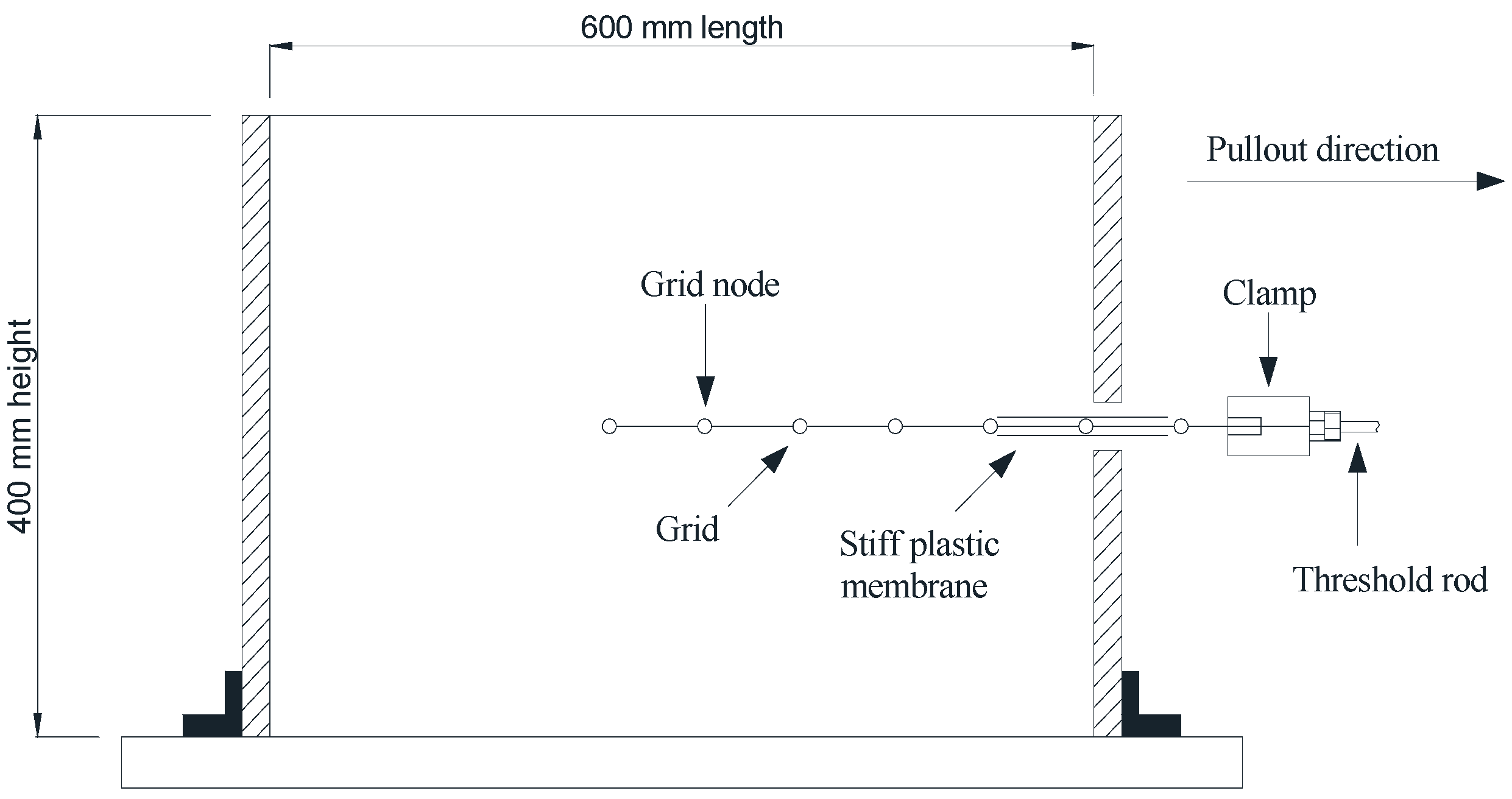
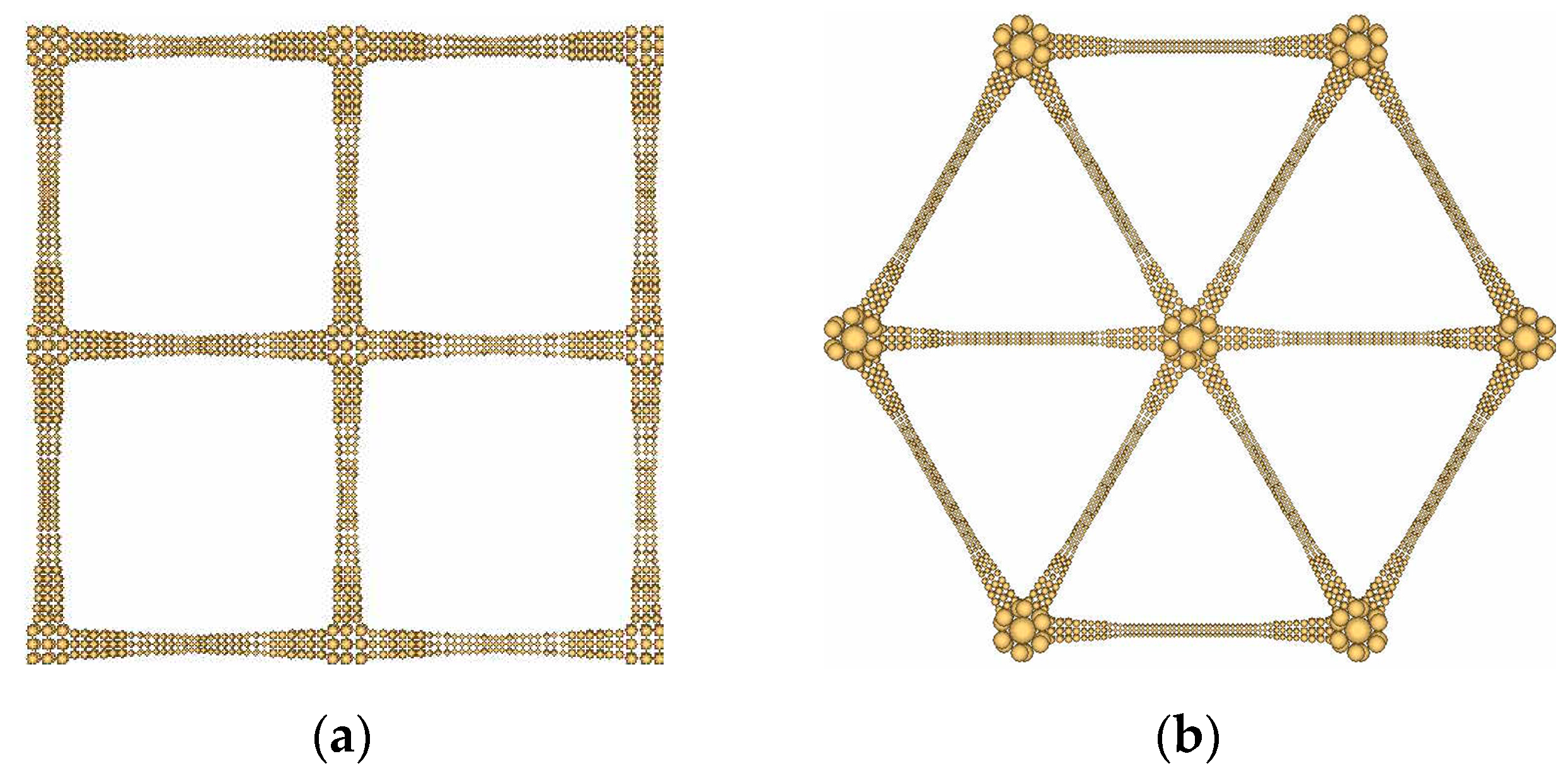
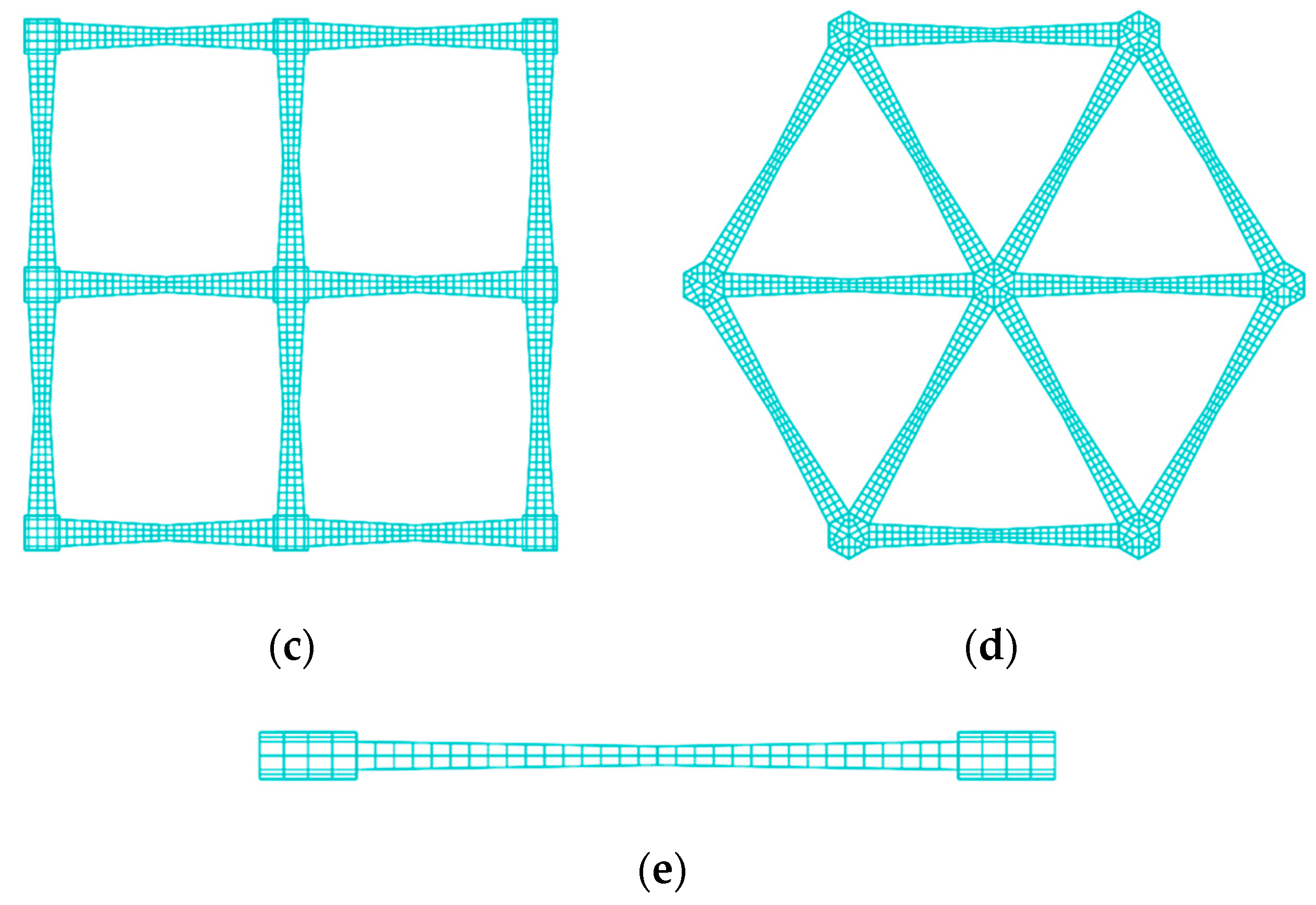

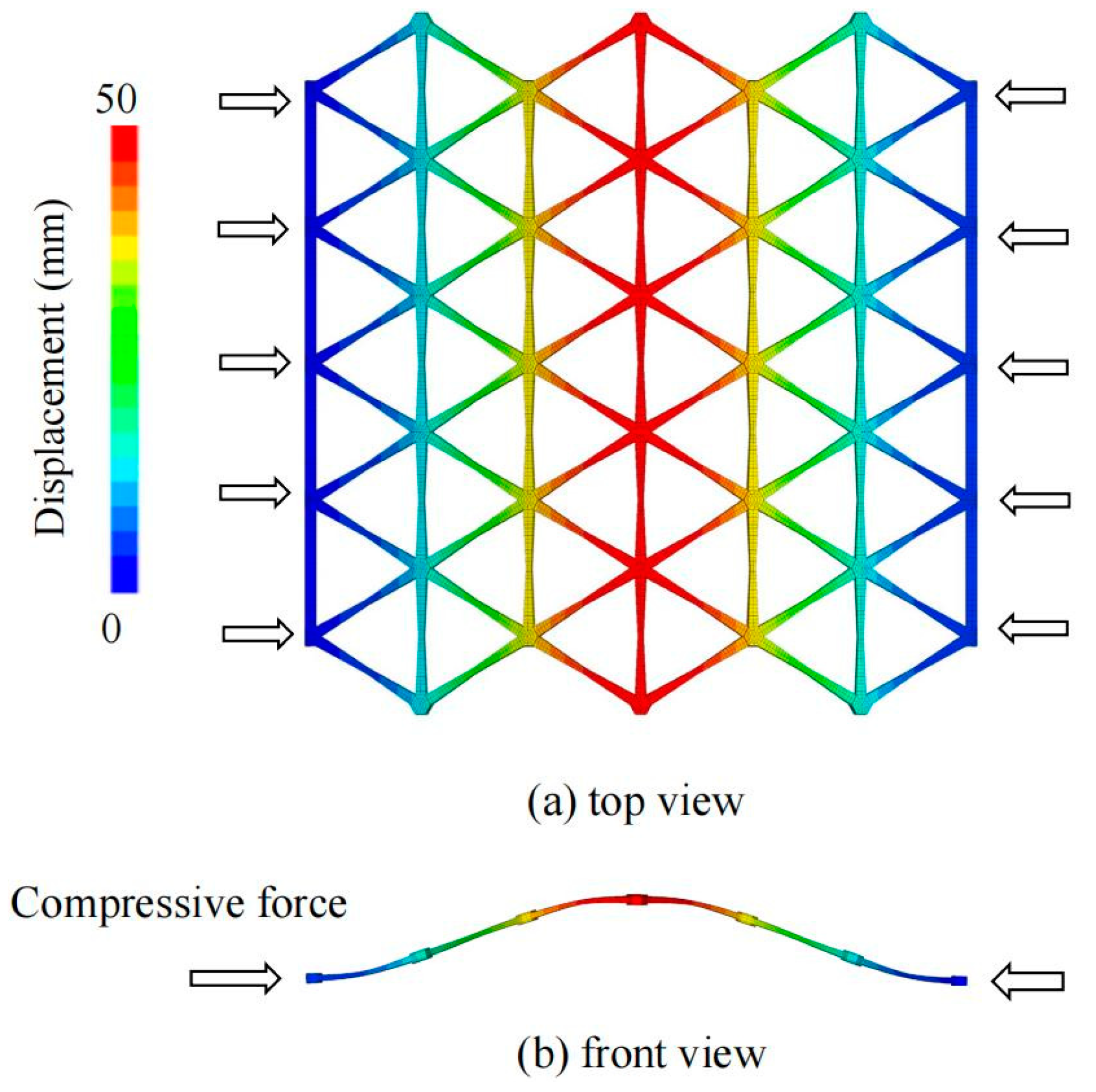
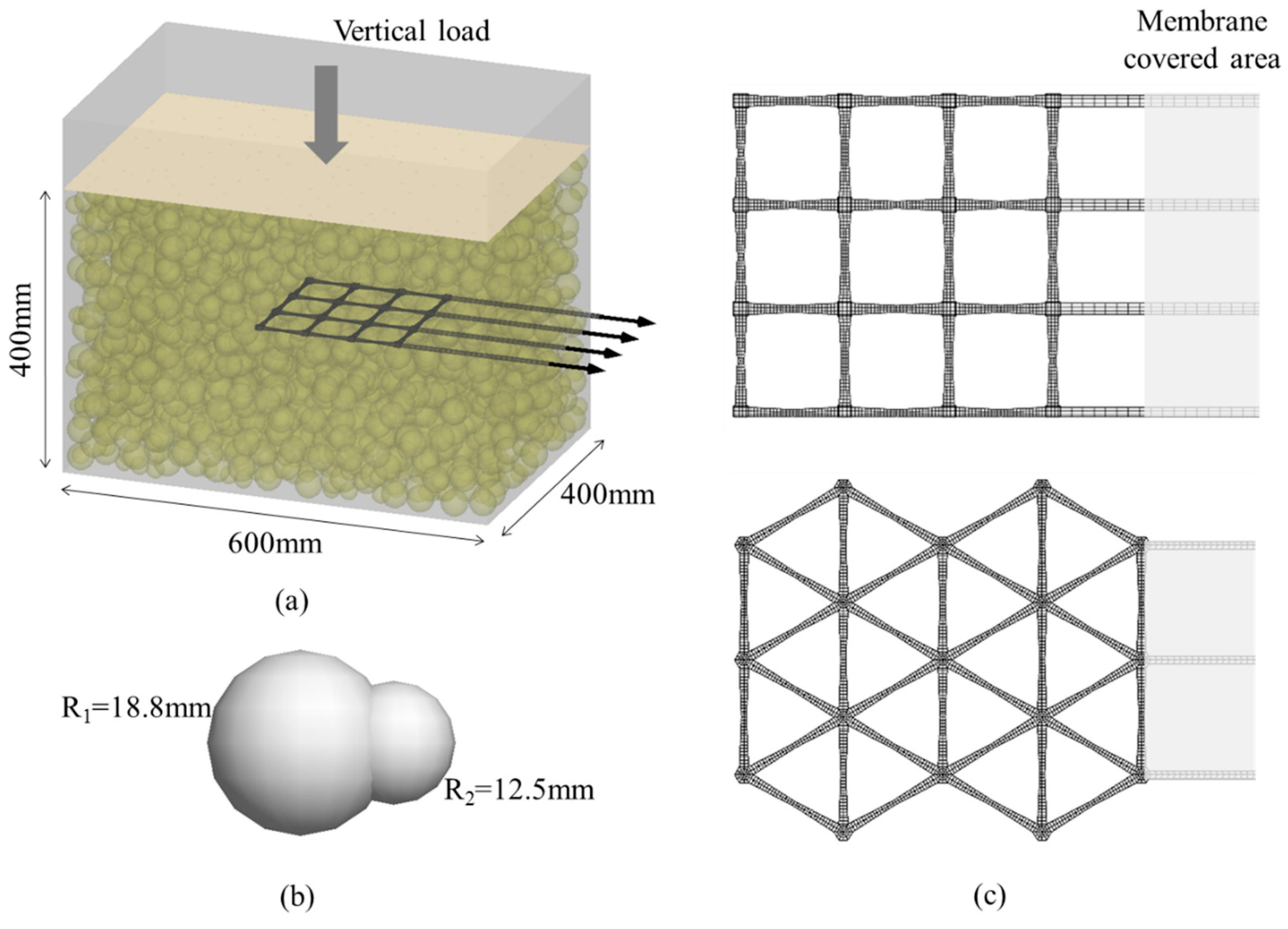
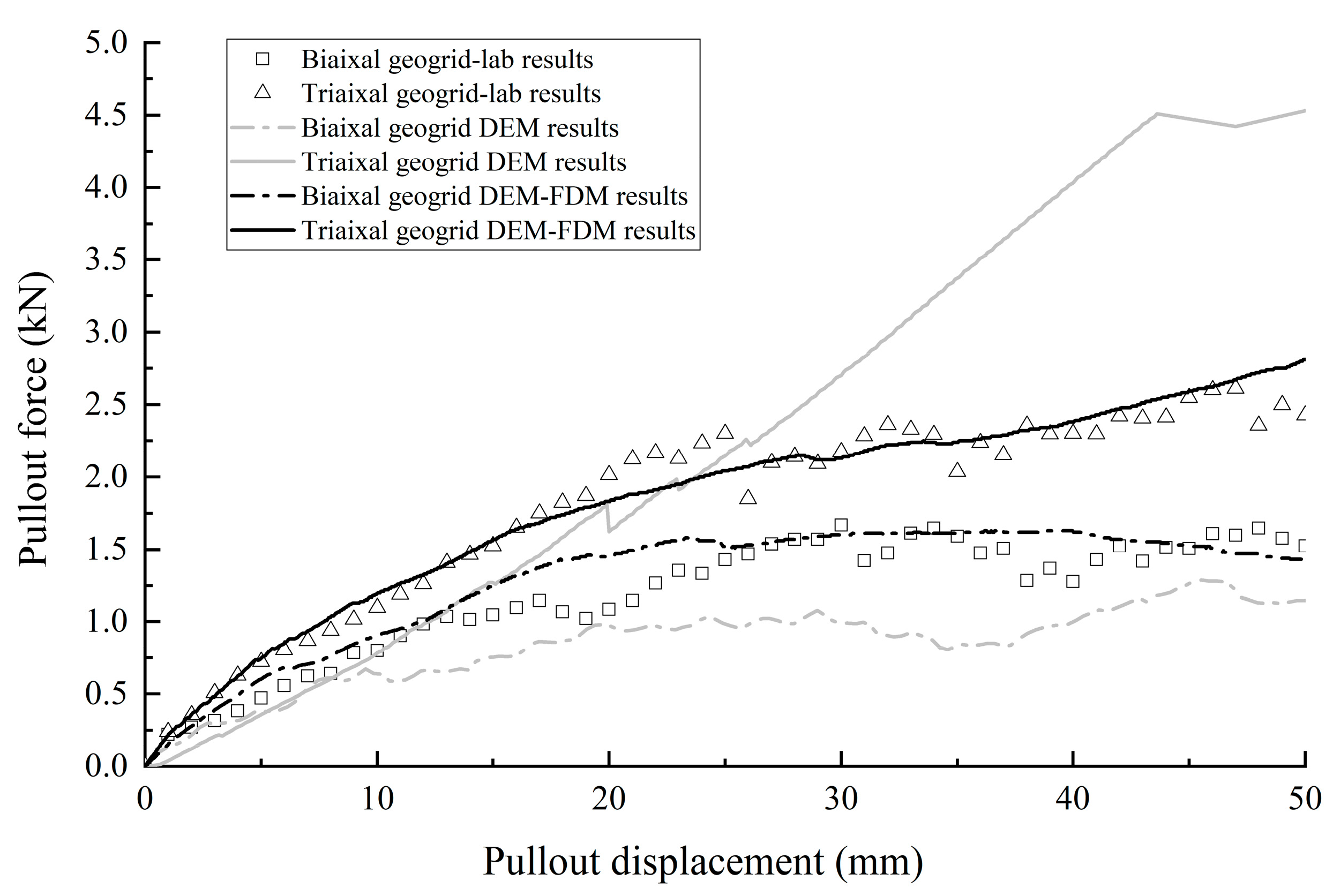
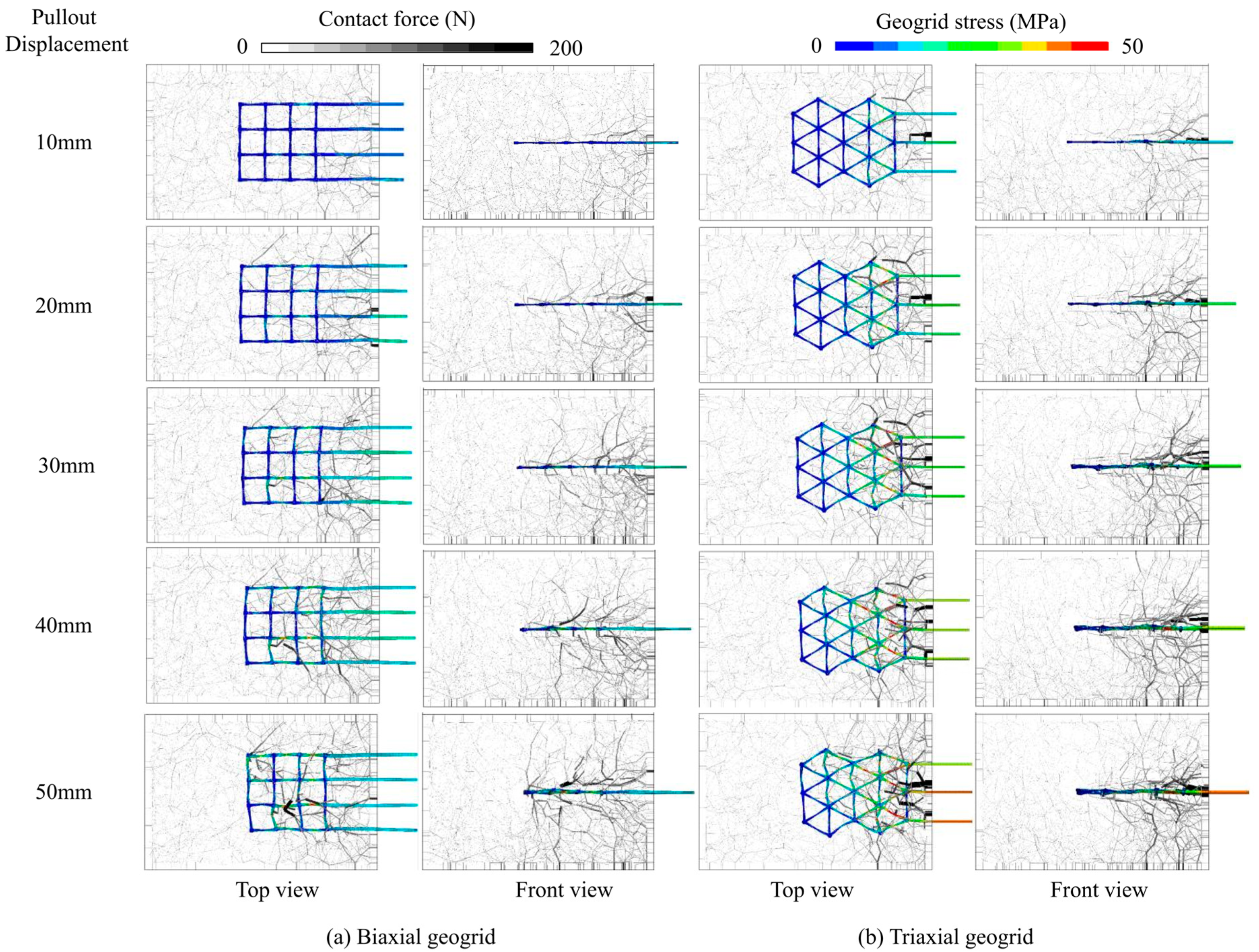
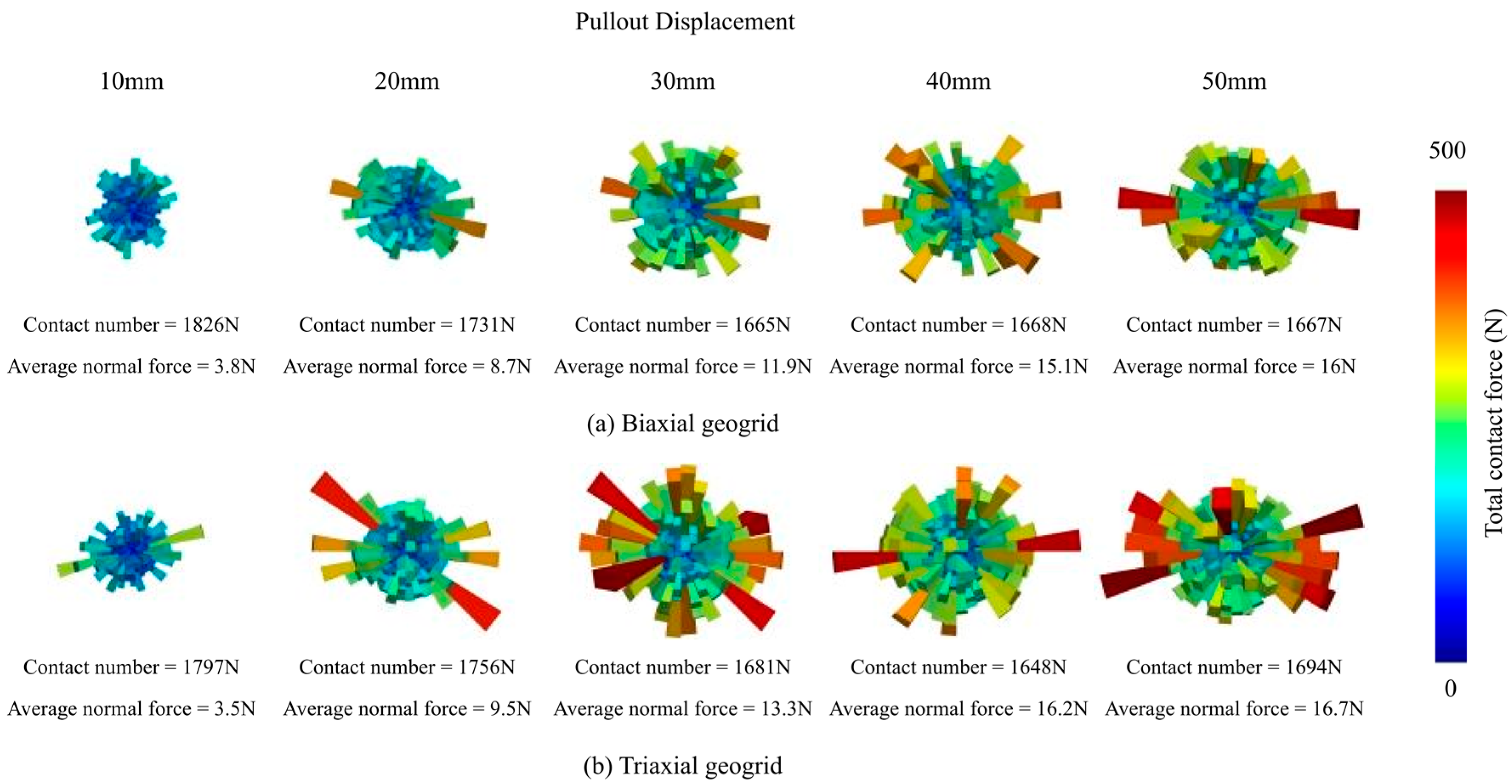
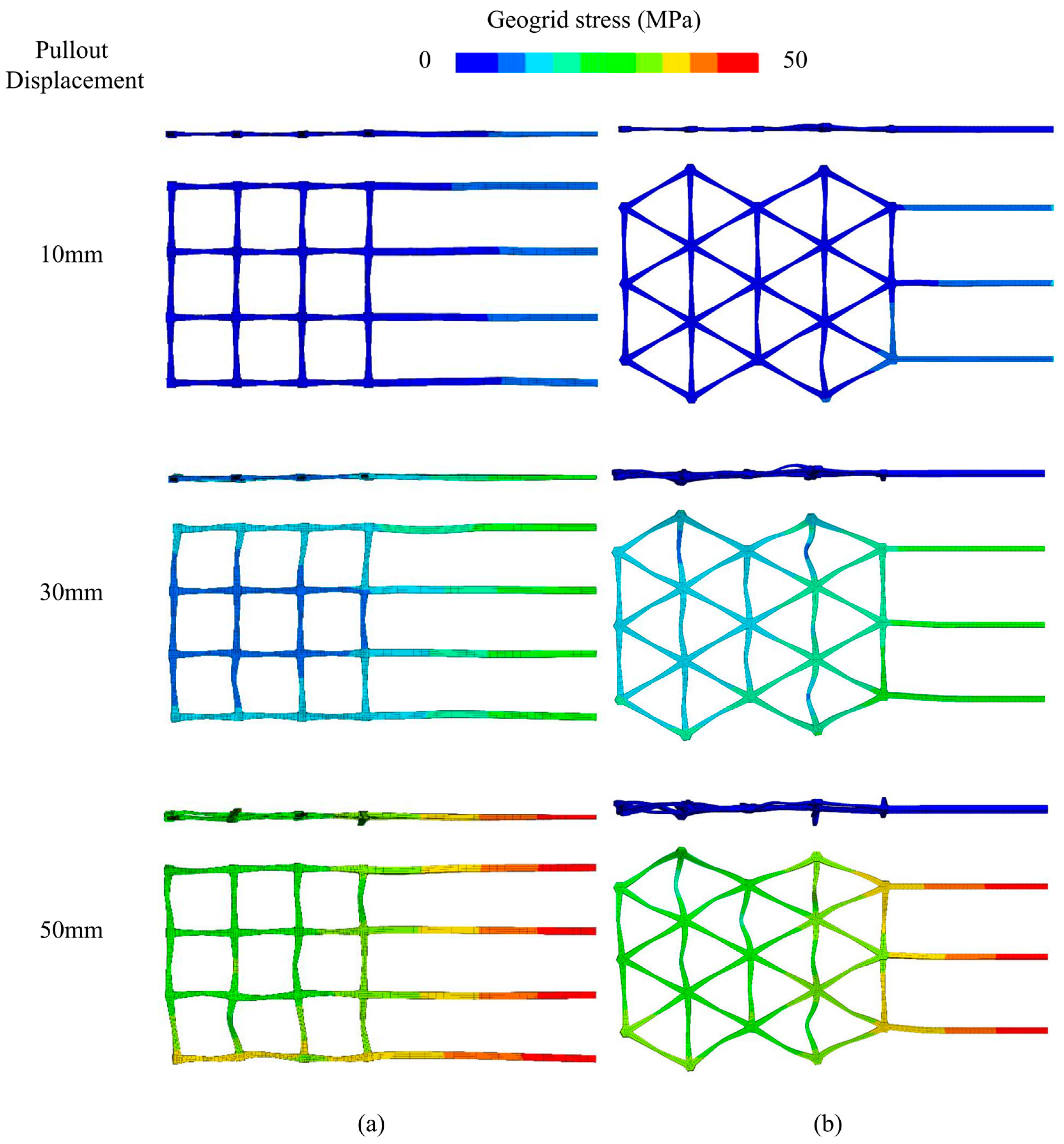
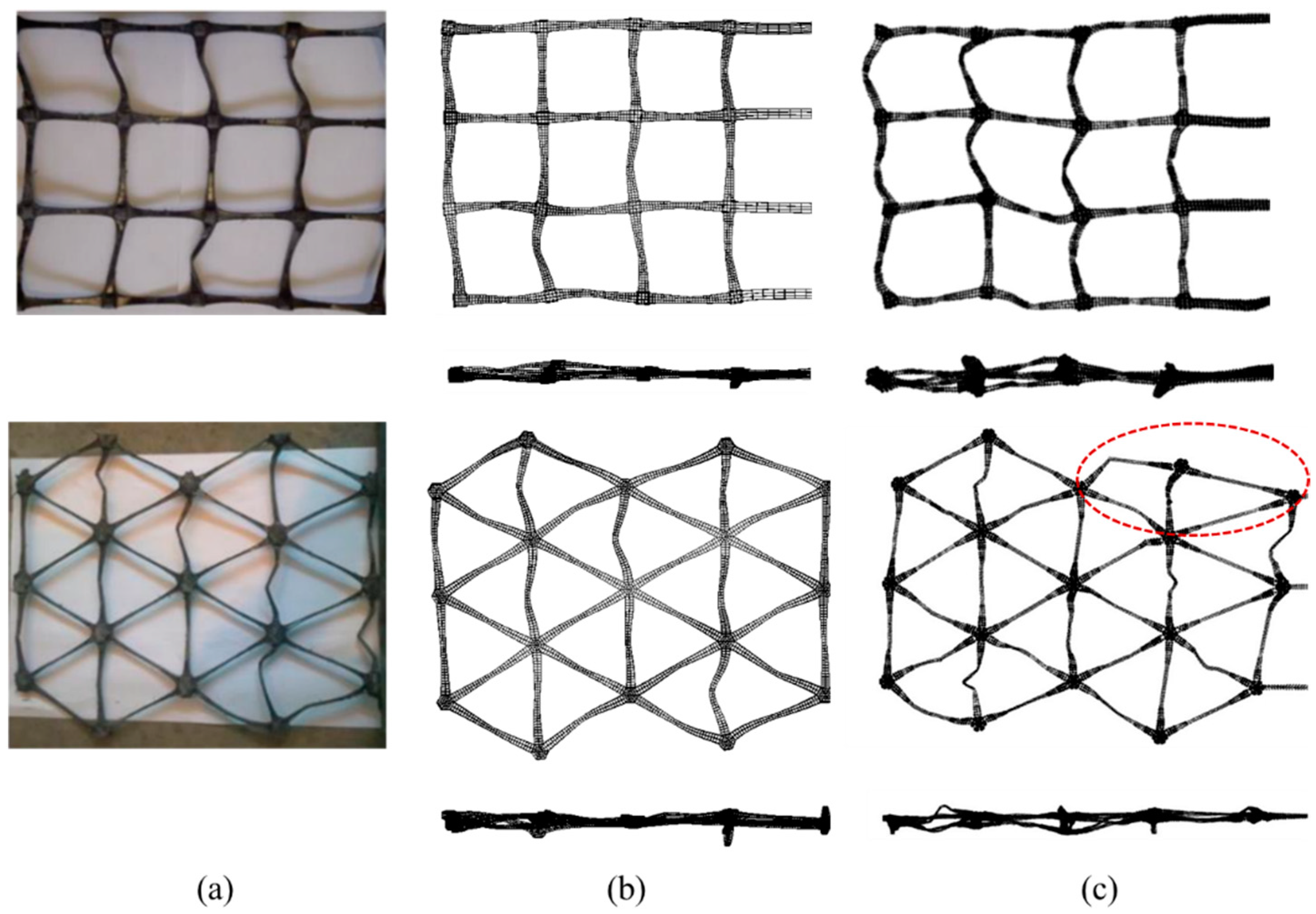
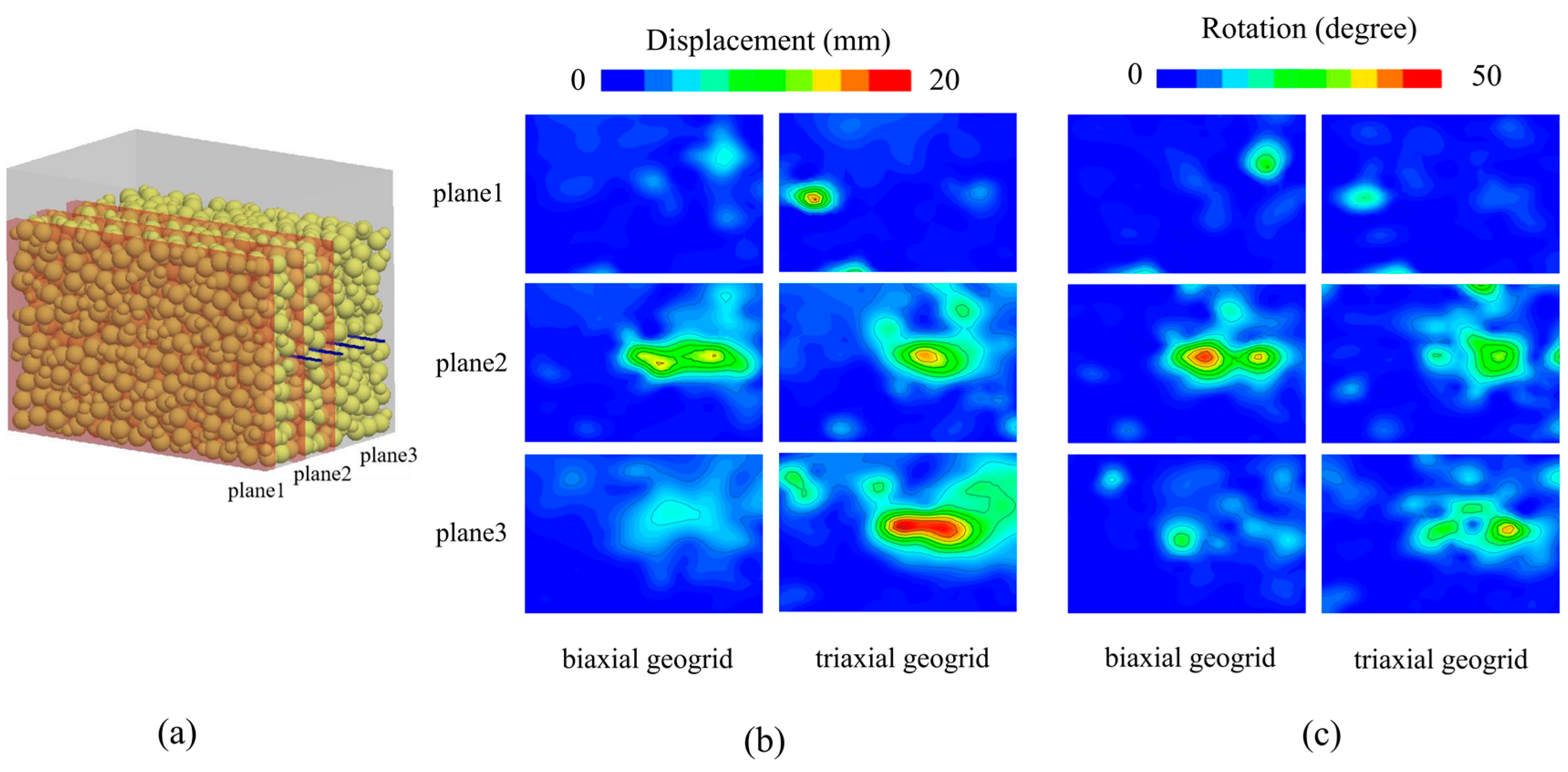
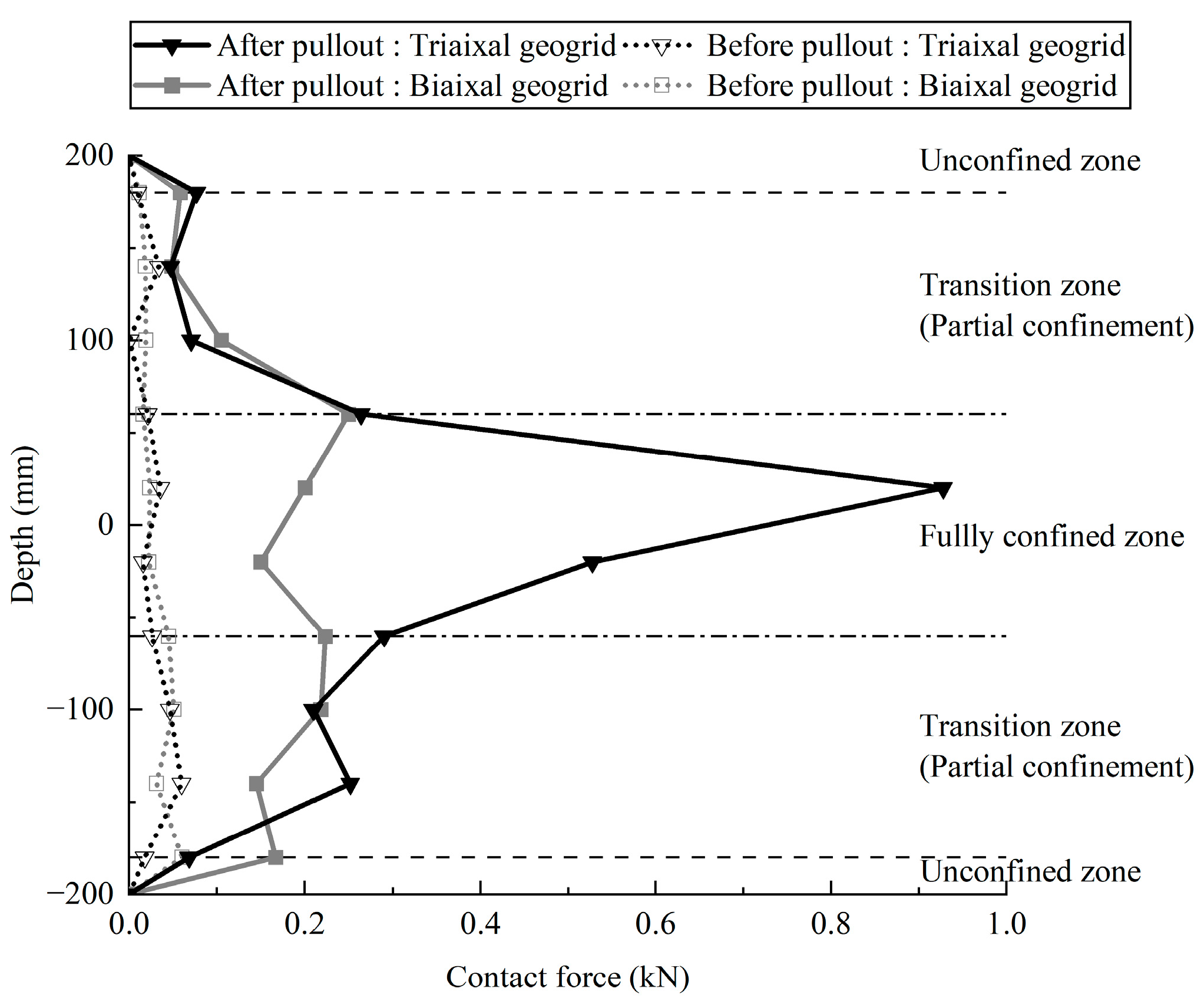

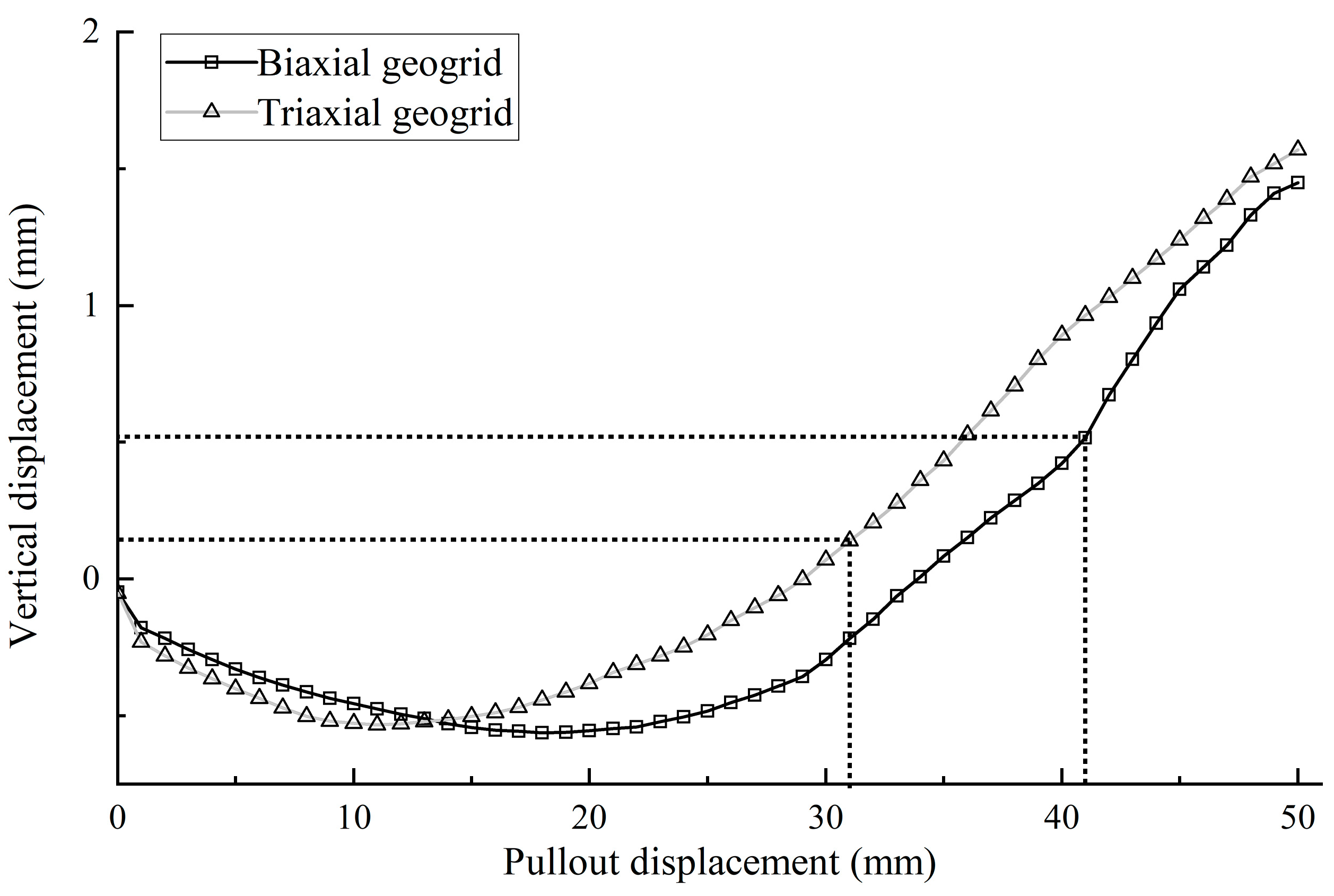
Publisher’s Note: MDPI stays neutral with regard to jurisdictional claims in published maps and institutional affiliations. |
© 2021 by the authors. Licensee MDPI, Basel, Switzerland. This article is an open access article distributed under the terms and conditions of the Creative Commons Attribution (CC BY) license (https://creativecommons.org/licenses/by/4.0/).
Share and Cite
Fu, J.; Li, J.; Chen, C.; Rui, R. DEM-FDM Coupled Numerical Study on the Reinforcement of Biaxial and Triaxial Geogrid Using Pullout Test. Appl. Sci. 2021, 11, 9001. https://doi.org/10.3390/app11199001
Fu J, Li J, Chen C, Rui R. DEM-FDM Coupled Numerical Study on the Reinforcement of Biaxial and Triaxial Geogrid Using Pullout Test. Applied Sciences. 2021; 11(19):9001. https://doi.org/10.3390/app11199001
Chicago/Turabian StyleFu, Jianjun, Junfeng Li, Cheng Chen, and Rui Rui. 2021. "DEM-FDM Coupled Numerical Study on the Reinforcement of Biaxial and Triaxial Geogrid Using Pullout Test" Applied Sciences 11, no. 19: 9001. https://doi.org/10.3390/app11199001
APA StyleFu, J., Li, J., Chen, C., & Rui, R. (2021). DEM-FDM Coupled Numerical Study on the Reinforcement of Biaxial and Triaxial Geogrid Using Pullout Test. Applied Sciences, 11(19), 9001. https://doi.org/10.3390/app11199001






